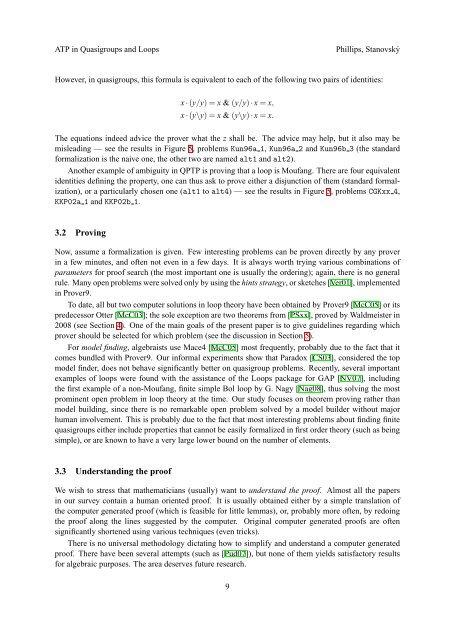Automated Theorem Proving in Quasigroup and Loop Theory
Automated Theorem Proving in Quasigroup and Loop Theory
Automated Theorem Proving in Quasigroup and Loop Theory
You also want an ePaper? Increase the reach of your titles
YUMPU automatically turns print PDFs into web optimized ePapers that Google loves.
ATP <strong>in</strong> <strong>Quasigroup</strong>s <strong>and</strong> <strong>Loop</strong>s<br />
Phillips, Stanovský<br />
However, <strong>in</strong> quasigroups, this formula is equivalent to each of the follow<strong>in</strong>g two pairs of identities:<br />
x · (y/y) = x & (y/y) · x = x,<br />
x · (y\y) = x & (y\y) · x = x.<br />
The equations <strong>in</strong>deed advice the prover what the z shall be. The advice may help, but it also may be<br />
mislead<strong>in</strong>g — see the results <strong>in</strong> Figure 5, problems Kun96a 1, Kun96a 2 <strong>and</strong> Kun96b 3 (the st<strong>and</strong>ard<br />
formalization is the naive one, the other two are named alt1 <strong>and</strong> alt2).<br />
Another example of ambiguity <strong>in</strong> QPTP is prov<strong>in</strong>g that a loop is Moufang. There are four equivalent<br />
identities def<strong>in</strong><strong>in</strong>g the property, one can thus ask to prove either a disjunction of them (st<strong>and</strong>ard formalization),<br />
or a particularly chosen one (alt1 to alt4) — see the results <strong>in</strong> Figure 5, problems CGKxx 4,<br />
KKP02a 1 <strong>and</strong> KKP02b 1.<br />
3.2 <strong>Prov<strong>in</strong>g</strong><br />
Now, assume a formalization is given. Few <strong>in</strong>terest<strong>in</strong>g problems can be proven directly by any prover<br />
<strong>in</strong> a few m<strong>in</strong>utes, <strong>and</strong> often not even <strong>in</strong> a few days. It is always worth try<strong>in</strong>g various comb<strong>in</strong>ations of<br />
parameters for proof search (the most important one is usually the order<strong>in</strong>g); aga<strong>in</strong>, there is no general<br />
rule. Many open problems were solved only by us<strong>in</strong>g the h<strong>in</strong>ts strategy, or sketches [Ver01], implemented<br />
<strong>in</strong> Prover9.<br />
To date, all but two computer solutions <strong>in</strong> loop theory have been obta<strong>in</strong>ed by Prover9 [McC05] or its<br />
predecessor Otter [McC03]; the sole exception are two theorems from [PSxx], proved by Waldmeister <strong>in</strong><br />
2008 (see Section 4). One of the ma<strong>in</strong> goals of the present paper is to give guidel<strong>in</strong>es regard<strong>in</strong>g which<br />
prover should be selected for which problem (see the discussion <strong>in</strong> Section 5).<br />
For model f<strong>in</strong>d<strong>in</strong>g, algebraists use Mace4 [McC05] most frequently, probably due to the fact that it<br />
comes bundled with Prover9. Our <strong>in</strong>formal experiments show that Paradox [CS03], considered the top<br />
model f<strong>in</strong>der, does not behave significantly better on quasigroup problems. Recently, several important<br />
examples of loops were found with the assistance of the <strong>Loop</strong>s package for GAP [NV07], <strong>in</strong>clud<strong>in</strong>g<br />
the first example of a non-Moufang, f<strong>in</strong>ite simple Bol loop by G. Nagy [Nag08], thus solv<strong>in</strong>g the most<br />
prom<strong>in</strong>ent open problem <strong>in</strong> loop theory at the time. Our study focuses on theorem prov<strong>in</strong>g rather than<br />
model build<strong>in</strong>g, s<strong>in</strong>ce there is no remarkable open problem solved by a model builder without major<br />
human <strong>in</strong>volvement. This is probably due to the fact that most <strong>in</strong>terest<strong>in</strong>g problems about f<strong>in</strong>d<strong>in</strong>g f<strong>in</strong>ite<br />
quasigroups either <strong>in</strong>clude properties that cannot be easily formalized <strong>in</strong> first order theory (such as be<strong>in</strong>g<br />
simple), or are known to have a very large lower bound on the number of elements.<br />
3.3 Underst<strong>and</strong><strong>in</strong>g the proof<br />
We wish to stress that mathematicians (usually) want to underst<strong>and</strong> the proof. Almost all the papers<br />
<strong>in</strong> our survey conta<strong>in</strong> a human oriented proof. It is usually obta<strong>in</strong>ed either by a simple translation of<br />
the computer generated proof (which is feasible for little lemmas), or, probably more often, by redo<strong>in</strong>g<br />
the proof along the l<strong>in</strong>es suggested by the computer. Orig<strong>in</strong>al computer generated proofs are often<br />
significantly shortened us<strong>in</strong>g various techniques (even tricks).<br />
There is no universal methodology dictat<strong>in</strong>g how to simplify <strong>and</strong> underst<strong>and</strong> a computer generated<br />
proof. There have been several attempts (such as [Pud07]), but none of them yields satisfactory results<br />
for algebraic purposes. The area deserves future research.<br />
9
















